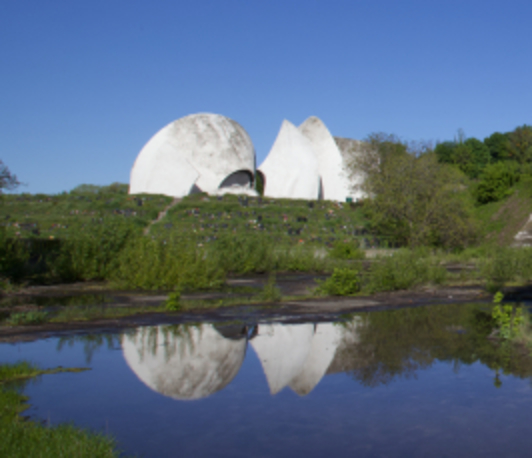In-Between: the Scylla and Charybdis of Official and non-official in the Late Soviet Epoch
Research Seminar
- Public event without registration
- Data: 18.03.2024
- Ora: 11:00 - 13:15
- Relatore: Alex Bykov, David Crowley, Agnė Narušytė
- Luogo: Villino Stroganoff, Via Gregoriana 22, 00187 Rome and online
- Contatto: mara.freiberg@biblhertz.it

This
research seminar is the first in the series of events “The Politics of Images”
that will cover several aspects of the imagery’s circulation in, but not
limited to, Ukraine. We seek the parallels within and beyond the former Soviet
space that would help to have a better comprehension of the images’ social
power and dispositifs. Organized within the ScienceForUkraine programme.
David Crowley, Art as
Dissent? (11.00–11.40)
Focusing on the 1960s and 1970s, the period which saw a revival of
modern art in the People’s Republics of Central/Eastern Europe, David Crowley
will reflect on the ways that dissenting and official culture in Hungary,
Poland and Czechoslovakia have been understood. The image of the artist as a
dissenting nonconformist was particularly attractive to Western European
intellectuals during this phase of the Cold War. The Biennale del dissenso
culturale, in Venice in 1977, for instance, featured an exhibition titled ‘La
nuova arte sovietica. Una prospettiva non ufficiale'. Ten years earlier, in 1967 Czech film-maker/artist
living in West Germany, Petr Sadecký, invented a fictitious artistic group -
Progressive Political Pornography (PPP), a network with cells in Soviet cities
- to tap Western enthusiasm for the image of the political rebel. But few
artists - in the region - accepted the mantle of ‘the dissident’. And, compared
to other branches of culture, very few visual artists were targeted as
‘enemies’ by the authorities. Drawing on the work for his 2017 exhibition
'Notes from the Underground', Crowley will examine the ways in which ‘official’
and ‘independent’ artistic practices were entangled.
David Crowley (National College of Art and Design, Dublin) has a specialist interest in modernism in art and design, with a focus on Eastern Europe under communist rule. He has written and edited more than a dozen books on the topic since the early 1990s. Crowley has also curated exhibitions in the UK, Germany and Poland including ‘Cold War Modern’ at the Victoria and Albert Museum in 2008–9 (with Jane Pavitt) and 'Notes from the Underground. Art and alternative music in Eastern Europe 1986-1994' (Łódź, 2017 / Berlin 2018, co-curated with Daniel Muzyczuk). His most recent exhibition was ‘Henryk Stażewski: Late Style’ at the Muzeum Sztuki in Łódź (2023).
Alex Bykov, “Liquidation Recommended”. Creation and
destruction of the Wall of Remembrance in Kyiv. (11.40–12.20)
The “Park of Memory” at the Kyiv Crematorium, created by the
artistic couple Ada Rybachuk and Volodymyr Melnychenko was probably one of the
most significant constructions of the second half of the 20th century in
Ukrainian architecture. Rybachuk and Melnichenko’s work belongs to the utopian
practices of a total work of art (Gesamtkunstwerk). They developed a complex
idea of the Memory Park from a landscape design, to the monumental Wall of
Remembrance and unique Halls of Farewell. A monumental Wall of Remembrance was
supposed to be the central element of this park: more than two hundred square
meters of artistic reliefs, which would be passed by funeral processions.
Creation of the Wall of Remembrance lasted for more than 10 years, but in early
1982, when its reliefs were almost finished, the Party leadership gave the
order to eliminate them. In no time The Wall of Remembrance was filled with
concrete. This grievous outcome was due to the fundamental differences between
the views of artists and the views of the leaders of the Communist Party of
Ukraine. The presentation will reveal artistic and personal struggles of Ada
Rybachuk and Volodymyr Melnychenko living and working under the Soviet
stipulations.
Alex Bykov is an architect exploring the legacy of Ukrainian urban planning of the second half of the 20th century. His main research methods are photographing, preserving and systematising rare archive materials and conducting interviews with authors and participants of the projects. Bykov is co-author of the books Soviet Modernism, Brutalism, Postmodernism. Buildings and Structures in Ukraine 1955-1991 in collaboration with Ievgenia Gubkina (2019) and Orthodox Chic in collaboration with Oleksandr Burlaka and Sasha Kurmaz (2020). Currently he is an assistant lecturer at the Faculty of Architecture (Brno University of Technology). Among his last projects were participating as co-curator at the exhibition “Retrotopia” in Berlin (2022-2023) and at the Ukrainian Pavilion at the Venice Biennale 2023.
Agnė Narušytė, Lithuanian Photographers’ Association:
Managing Creative Freedom, Collaboration, and Resistance (12.35–13.15)
Establishing the independent Lithuanian Photographers’ Association
in Vilnius in 1969 was, in itself, an act of resistance to the Soviet
occupation because all organisations had to be founded in Moscow and only then
would form their branches in the ‘republics’. Even before that, the so-called
School of Lithuanian Photography became a positive example discussed by the
most prominent Soviet photography historians and theorists and revered by
photographic communities all over the Soviet Union. By discussing the photo
album by Antanas Sutkus and Romualdas Rakauskas, Weekdays in Vilnius (1965),
and the ‘aesthetics of boredom’ practiced by young rebels in the 1980s, Agnė
Narušytė will show how the organisation balanced between allowing creative
freedom and satisfying ideological requirements.
Agnė Narušytė is an art critic, curator,
and researcher at the Lithuanian Culture Research Institute, a professor at the
Vilnius Academy of Art and the editor of the weekly 7 meno dienos. Her curated exhibitions include the post-war section
of the permanent exposition at the National Gallery of Art, Vilnius, which
opened in 2019. She has authored and edited numerous books, her most recent
monograph is Chronometers: Imagining Time
or Chronopolitics, Heterechrony and Experiences of Acceleration in Lithuanian
Art (Vilnius Academy of Arts, 2021, in Lithuanian).
It will possible to follow the event also ONLINE on our VIMEO CHANNEL: https://vimeo.com/event/4117645
Scientific Organization: Kateryna Filyuk and Oleksandra Osadcha